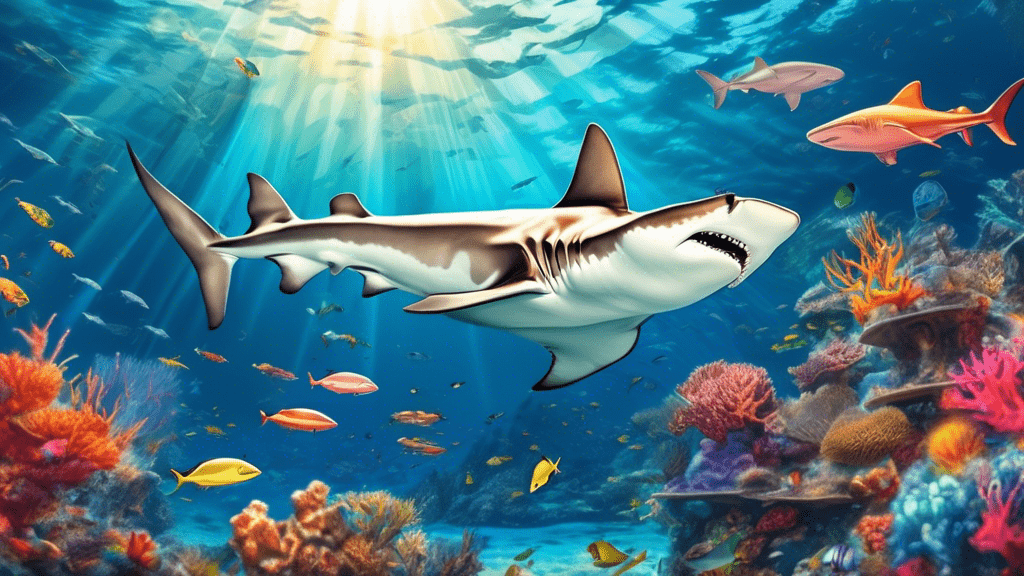Exploring the Majestic Great Hammerhead Shark

Exploring the Majestic Great Hammerhead Shark
The great hammerhead shark, with its distinctive hammer-shaped head and impressive size, stands as one of the most intriguing and majestic creatures in the marine world. This article delves into the biology, behavior, habitat, and conservation status of the great hammerhead shark, offering insights into the life of this magnificent ocean dweller.
Introduction to the Great Hammerhead Shark
The great hammerhead shark (Sphyrna mokarran) is the largest member of the hammerhead shark family. Characterized by its unique hammer or T-shaped head, known as the cephalofoil, this species can grow up to 20 feet (6 meters) in length and weigh as much as 1,000 pounds (450 kilograms). The great hammerhead roams the warmer waters of oceans worldwide, from coastal regions to off-shore, making it an incredibly widespread species.
Behavior and Diet
Great hammerhead sharks are solitary predators, often hunting alone. Their diet mainly consists of stingrays, smaller sharks, fish, squids, and crustaceans. The shark’s uniquely shaped head is not just for show; it is an evolutionary adaptation that improves its ability to find prey. Equipped with electroreceptors called ampullae of Lorenzini, the cephalofoil allows the shark to detect the minute electrical fields generated by the muscle movements of their prey. Furthermore, the wide-set eyes give them a better visual range to spot potential meals.
Habitat and Migration Patterns
These sharks prefer warm waters and are found in both coastal and offshore environments around the world. They are commonly seen in the Atlantic, Pacific, and Indian Oceans, especially around islands like the Bahamas, where they are a popular subject of ecotourism. Great hammerhead sharks are known to migrate seasonally, moving to cooler waters during the summer to give birth, as they are viviparous, meaning they give birth to live young rather than laying eggs.
Conservation Status
Unfortunately, the great hammerhead shark has been listed as Critically Endangered by the International Union for Conservation of Nature (IUCN). Overfishing, both targeted and accidental (bycatch), coupled with their slow reproductive rates, has led to a drastic decline in their populations. Their large fins are highly valued in the shark fin trade, a primary reason for their overexploitation. Conservation efforts are underway globally, including protective legislation, to try and curb the decline of these magnificent creatures.
Importance of Great Hammerhead Sharks in the Ecosystem
As apex predators, great hammerhead sharks play a crucial role in maintaining the health of marine ecosystems. By preying on the weak and the sick, they help to keep fish populations healthy and in balance. Their decline can lead to an unhealthy increase in the populations of their prey, which can then have a cascading and detrimental effect on the marine environment.
FAQs about the Great Hammerhead Shark
What makes the great hammerhead shark’s head shape so special?
The great hammerhead shark’s head, known as the cephalofoil, serves multiple purposes. Its wide span allows for better maneuverability and agility when hunting. The positioning of their eyes, set far apart on the edges of the cephalofoil, gives them a superior field of vision. Additionally, the hammer shape aids in sensing prey through the detection of electric fields emitted by other creatures, making them highly effective hunters.
How does the great hammerhead shark reproduce?
The great hammerhead shark is viviparous, meaning they give birth to live young. A female can have a litter ranging from 6 to 55 pups, depending on her size. The gestation period usually lasts about 11 months. Unlike some other shark species, great hammerheads do not lay eggs. Newborns are usually around 20 to 27 inches long (50 to 70 cm) and are independent from birth, receiving no further care from the mother.
Are great hammerhead sharks dangerous to humans?
There are very few documented cases of great hammerhead sharks attacking humans. They are generally not considered a significant threat. Like most sharks, they may attack if provoked or if they feel threatened, but such incidents are extremely rare. Most interactions between humans and great hammerhead sharks, especially during guided tours, occur without any aggressive behavior from the sharks.
What can be done to help conserve great hammerhead sharks?
Conserving great hammerhead sharks requires a multifaceted approach. Establishing and enforcing protective legislation to curb overfishing and illegal fishing practices is crucial. This includes measures such as fishing quotas, protected marine areas where sharks can safely breed and hunt, and a ban on the trade of shark fins. Public education and awareness campaigns can also help, by reducing the demand for shark fin soup and other products that contribute to the decline in shark populations. Responsible tourism practices can further aid in their conservation, by ensuring that wildlife encounters do not harm the sharks or their habitat.
How do researchers study great hammerhead sharks?
Researchers study great hammerhead sharks through various methods. Tagging and tracking technology is commonly used to monitor their migration patterns, habitat use, and behavior. Satellite tags allow scientists to follow the sharks over vast distances, gaining insights into their migratory routes and deep diving behaviors. Additionally, studying genetic material, observing their diet through analysis of stomach contents, and monitoring their growth and reproduction in both wild and controlled environments help researchers understand the complexities of their life cycle and ecological role.
Conclusion
The great hammerhead shark, with its distinctive head and magnificent size, is one of the ocean’s most iconic creatures. Despite their formidable appearance, they face significant threats from human activities that have led to a critical decline in their populations. Understanding the behavior, habitat, and challenges faced by these sharks is crucial for their conservation. Through protective legislation, public education, and responsible tourism, we can help ensure the survival of the great hammerhead shark for future generations to marvel at and study.